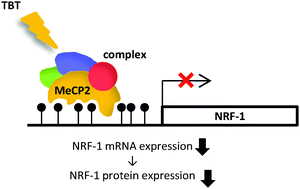当前位置:
X-MOL 学术
›
Metallomics
›
论文详情
Our official English website, www.x-mol.net, welcomes your
feedback! (Note: you will need to create a separate account there.)
Tributyltin induces epigenetic changes and decreases the expression of nuclear respiratory factor-1†
Metallomics ( IF 2.9 ) Pub Date : 2018-01-04 00:00:00 , DOI: 10.1039/c7mt00290d Saki Hanaoka 1, 2, 3, 4 , Keishi Ishida 1, 2, 3, 4 , Saki Tanaka 1, 2, 3, 4 , Shuichiro Sakamoto 1, 2, 3, 4 , Katsuhiro Okuda 1, 2, 3, 4 , Seigo Sanoh 1, 2, 3, 4 , Shigeru Ohta 1, 2, 3, 4 , Yaichiro Kotake 1, 2, 3, 4
Metallomics ( IF 2.9 ) Pub Date : 2018-01-04 00:00:00 , DOI: 10.1039/c7mt00290d Saki Hanaoka 1, 2, 3, 4 , Keishi Ishida 1, 2, 3, 4 , Saki Tanaka 1, 2, 3, 4 , Shuichiro Sakamoto 1, 2, 3, 4 , Katsuhiro Okuda 1, 2, 3, 4 , Seigo Sanoh 1, 2, 3, 4 , Shigeru Ohta 1, 2, 3, 4 , Yaichiro Kotake 1, 2, 3, 4
Affiliation

|
Tributyltin (TBT), a common organotin environmental pollutant, has been widely used as a component of marine antifouling paints. We previously reported that exposure to TBT inhibits the expression and DNA binding of nuclear respiratory factor-1 (NRF-1) and causes neurotoxicity. In the present study, we focused on the epigenetic effects of TBT and investigated whether TBT decreases NRF-1 expression via epigenetic modifications in SH-SY5Y human neuroblastoma cells. First, we found that exposure to 300 nM TBT decreases NRF-1 expression. We examined epigenetic changes induced by TBT, and showed that TBT causes hypermethylation of the NRF-1 promoter region, increases the amount of methyl-CpG-binding protein 2 (MeCP2) bound to the NRF-1 promoter, and alters the expression of DNA methyltransferases and ten-eleven translocation (TET) demethylation enzymes. These results suggest that epigenetic changes play an important role in regulation of NRF-1 expression. Next, we investigated effect of NRF-1 expression decrease on cells, and TBT reduces mitochondrial membrane potential and overexpression of NRF-1 rescued this reduction in membrane potential. Thus, we suggested that NRF-1 is important for maintaining mitochondrial membrane potential. Our study indicates that TBT causes epigenetic changes such as hypermethylation, which increases recruitment of MeCP2 to the NRF-1 promoter and probably lead to decreased of NRF-1 expression and mitochondrial membrane potential. Therefore, this research provides new evidence of the epigenetic action caused by organotin.
中文翻译:

三丁基锡诱导表观遗传变化,并且降低核呼吸因子1的表达†
三丁基锡(TBT)是一种常见的有机锡环境污染物,已被广泛用作船舶防污漆的成分。我们以前曾报道过,接触TBT会抑制核呼吸因子1(NRF-1)的表达和DNA结合,并引起神经毒性。在本研究中,我们集中于TBT的表观遗传效应,并研究TBT是否通过以下途径降低NRF-1表达:SH-SY5Y人神经母细胞瘤细胞的表观遗传修饰。首先,我们发现暴露于300 nM TBT会降低NRF-1表达。我们检查了TBT诱导的表观遗传变化,发现TBT会导致NRF-1启动子区域甲基化,增加与NRF-1启动子结合的甲基-CpG结合蛋白2(MeCP2)的量,并改变DNA的表达甲基转移酶和十一十一易位(TET)去甲基化酶。这些结果表明表观遗传变化在调节NRF-1表达中起着重要作用。接下来,我们研究了NRF-1表达降低对细胞的影响,TBT降低了线粒体膜电位,NRF-1的过表达挽救了膜电位的这种降低。因此,我们认为NRF-1对于维持线粒体膜电位很重要。我们的研究表明,TBT会引起表观遗传变化,例如甲基化过高,从而增加MeCP2向NRF-1启动子的募集,并可能导致NRF-1表达和线粒体膜电位降低。因此,这项研究提供了由有机锡引起的表观遗传作用的新证据。
更新日期:2018-01-04
中文翻译:

三丁基锡诱导表观遗传变化,并且降低核呼吸因子1的表达†
三丁基锡(TBT)是一种常见的有机锡环境污染物,已被广泛用作船舶防污漆的成分。我们以前曾报道过,接触TBT会抑制核呼吸因子1(NRF-1)的表达和DNA结合,并引起神经毒性。在本研究中,我们集中于TBT的表观遗传效应,并研究TBT是否通过以下途径降低NRF-1表达:SH-SY5Y人神经母细胞瘤细胞的表观遗传修饰。首先,我们发现暴露于300 nM TBT会降低NRF-1表达。我们检查了TBT诱导的表观遗传变化,发现TBT会导致NRF-1启动子区域甲基化,增加与NRF-1启动子结合的甲基-CpG结合蛋白2(MeCP2)的量,并改变DNA的表达甲基转移酶和十一十一易位(TET)去甲基化酶。这些结果表明表观遗传变化在调节NRF-1表达中起着重要作用。接下来,我们研究了NRF-1表达降低对细胞的影响,TBT降低了线粒体膜电位,NRF-1的过表达挽救了膜电位的这种降低。因此,我们认为NRF-1对于维持线粒体膜电位很重要。我们的研究表明,TBT会引起表观遗传变化,例如甲基化过高,从而增加MeCP2向NRF-1启动子的募集,并可能导致NRF-1表达和线粒体膜电位降低。因此,这项研究提供了由有机锡引起的表观遗传作用的新证据。











































 京公网安备 11010802027423号
京公网安备 11010802027423号